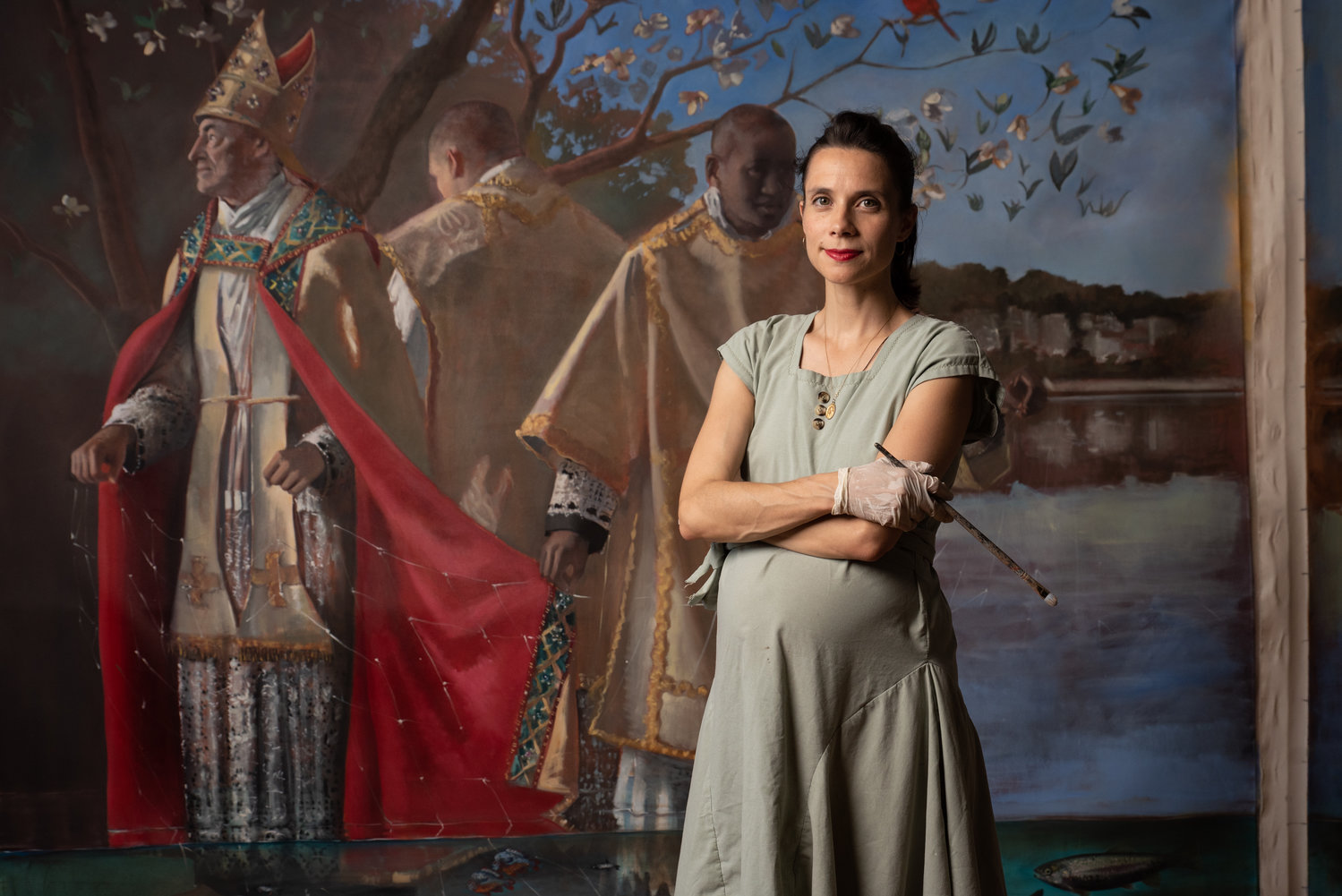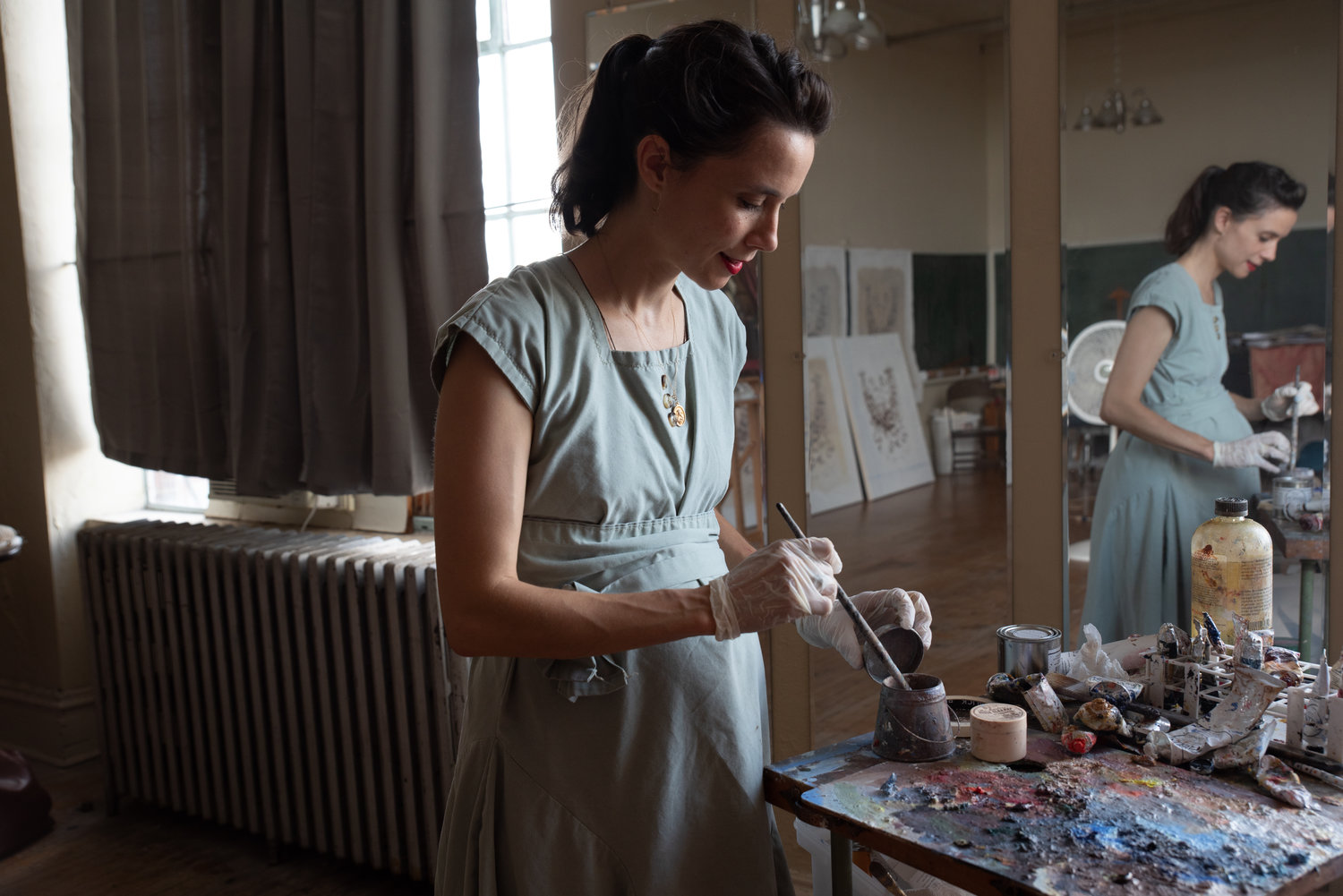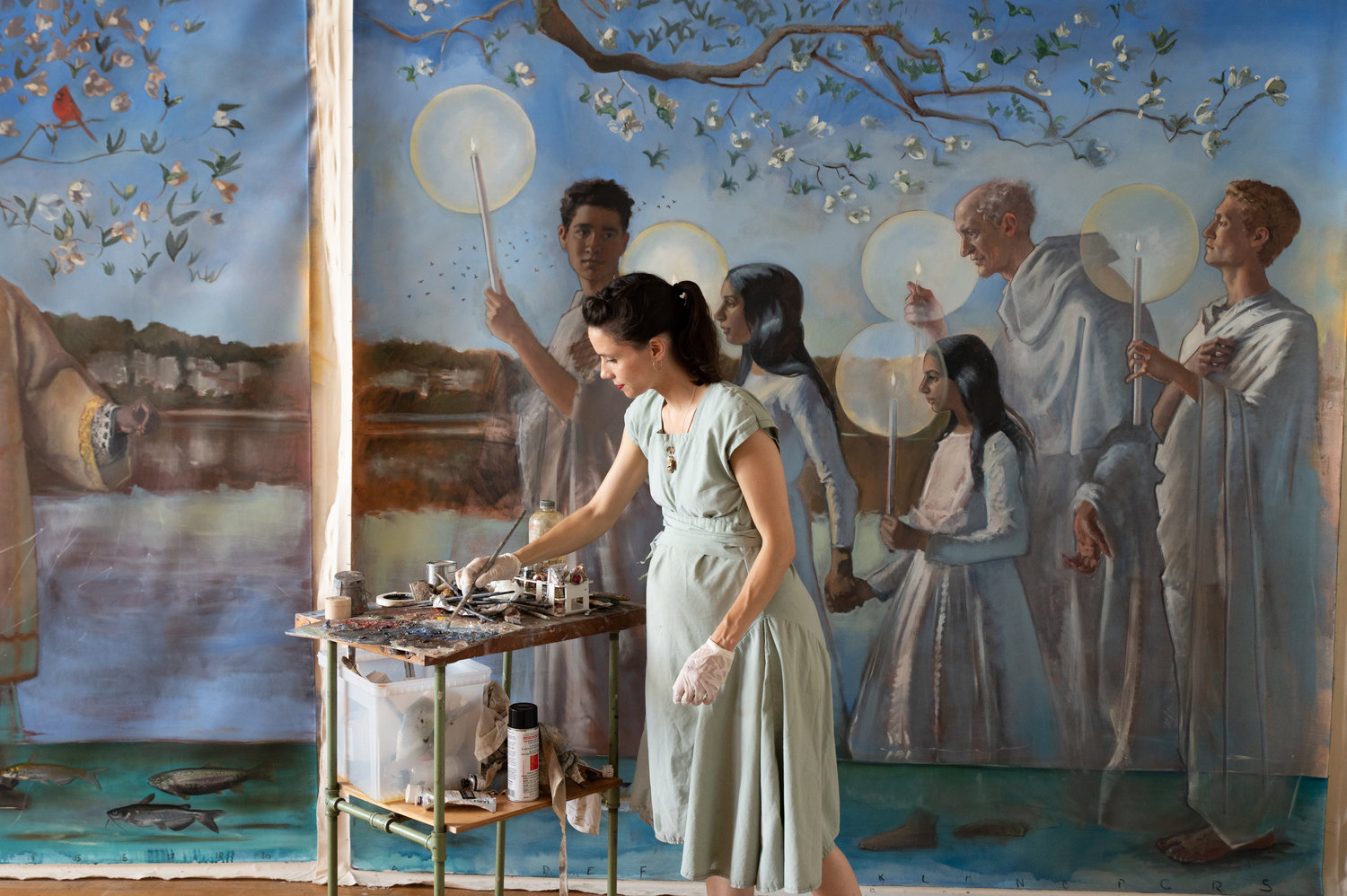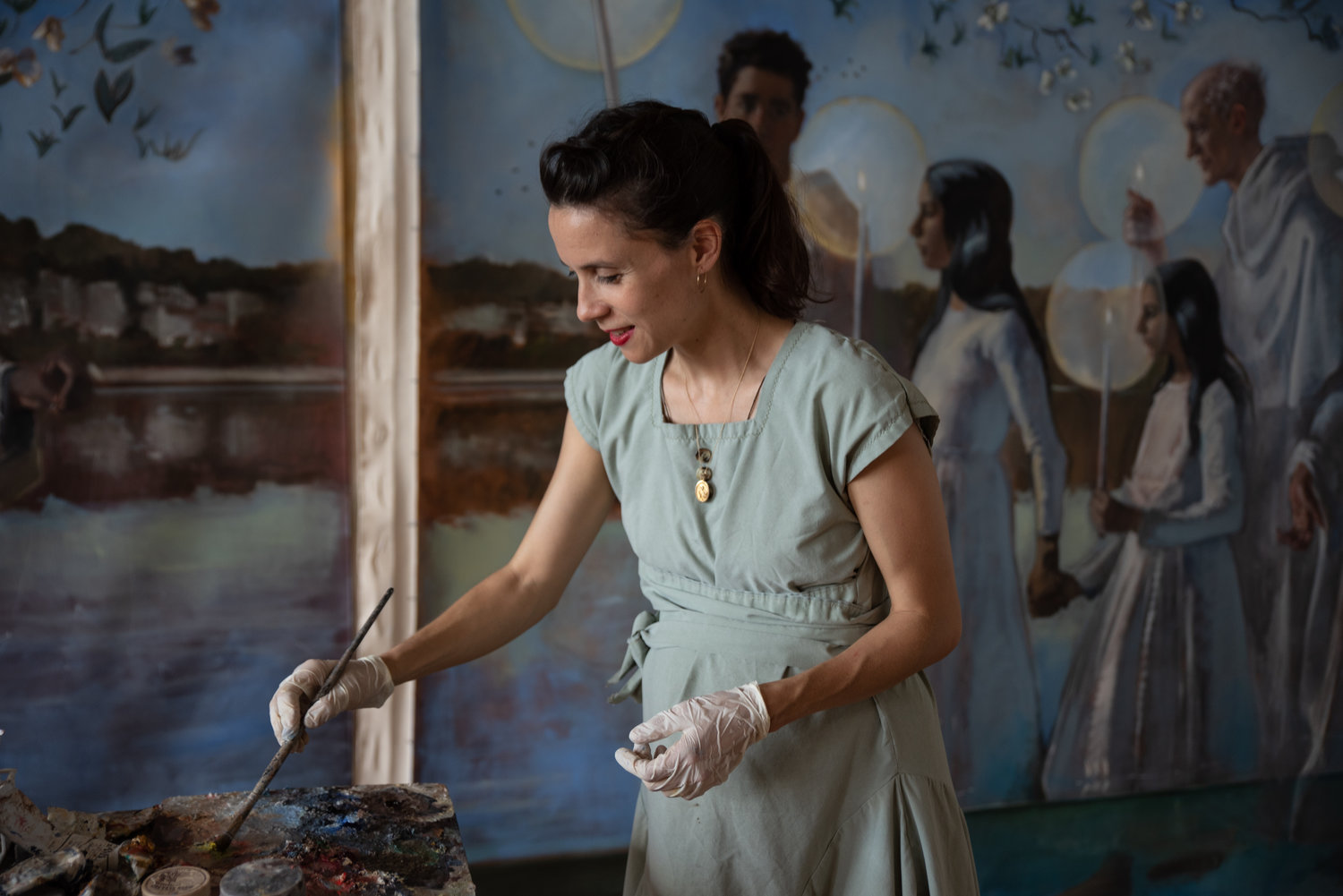Murals being created for Cathedral illustrate the spiritual reality of Baptism
Artist sees her work as part of Church’s mission to evangelize

CLICK HERE to see a gallery of photos.
Northern sunlight illuminates a panorama of Missouri wildlife, flowers and fauna.
A bishop, a priest and a deacon lead a procession through a glorified version of the Missouri River.
People of all ages, backgrounds and skin tones are taken up in the gathering, which close examination reveals to be expedited by a fishing net, being dragged by the clergymen.
“And caught up in the net, in addition to all the beautiful native species, are the newly baptized, who are carrying their Baptism candles and representing individuals from all walks of life who are crossing the spiritual Jordan into the Promised Land of new life in Christ,” stated Gwyneth Thompson-Briggs (gwyneththompsonbriggs.com), a painter of sacred art.
This vivid illustration will adorn the walls and octagonal ceiling of the new baptistery in the Cathedral of St. Joseph in Jefferson City.
The work is part of a substantial, yearlong renovation, expansion and renewal of the 53-year-old Cathedral, focused on enhancing its beauty, functionality, capacity for hospitality and uniquely Catholic identity.
Bishop W. Shawn McKnight directed Mrs. Thompson-Briggs to include images of distinctly Missouri wildlife and hints of the bluffs of the Missouri River in the distance.
She incorporated native trout and catfish in the water, flowering dogwood trees on the banks, and cardinals and bluebirds in the air.
“The idea is to visually enculturate the universal call to Baptism within the Diocese of Jefferson City,” Mrs. Thompson-Briggs explained “to show how Christ’s call to baptize all nations (Matthew 28:19) is also a call to Baptism for the people of this particular place.”
The entire work is made up of three large panels, each about 9 by 9 feet, and eight smaller panels to adorn the octagonal cupola in the ceiling.
All are being rendered in oil-based paint on thick canvas, which will be secured to the baptistery walls.
The cupola will be situated above the marble baptismal font, which will also have eight sides — representing the six days of Creation, the Sabbath, and the day on which Jesus rose from the dead.
The final panel includes two souls — one receiving Baptism by blood, the other receiving Baptism by desire.
“Bishop McKnight wanted to be sure that all three forms of Baptism — by water, by blood and by desire — were represented,” Mrs. Thompson-Briggs noted, referring to the Catechism of the Catholic Church, #1257-1261.
Each of the smaller panels for the cupola includes a fruit-laden garland known as a festoon.
“All the fruits are Missouri fruits,” Mrs. Thompson-Briggs noted. “In the center of the cupola is a depiction of the Holy Spirit. So the festoons also symbolically represent the spiritual fruits that are transmitted through the grace of Baptism.”
“With them for life”
Mrs. Thompson-Briggs describes herself as “a contemporary sacred artist in the perennial Western tradition.”
She often invokes the intercession of Blessed Fra Angelico, who was a 15th-century Dominican friar and artist in Florence.
“His works are so heavenly,” she said. “If I were to be placed in a monastic cell with one painting for the rest of my days, I would want it to be one of his.”
Seeing his works adorning the monks’ cells in the Friary of San Marco in Florence, Italy, helped her understand the intimacy that is possible between art and the person viewing it.
“Contemplating one single great work of art should be enough to bring you closer to God,” she stated.
Mrs. Thompson-Briggs holds advanced degrees in art and engineering and has served as a visiting fellow and artist-in-residence at The Thomas More College of Liberal Arts in Merrimack, New Hampshire.
She and her husband, Andrew Thompson-Briggs, co-founded the Catholic Artists’ Directory, a consortium of Catholic artists, composers and designers who work across all disciplines.
“The Catholic Artists Directory was born out of a desire to help perpetuate the many skills in the arts that are a part of our Catholic tradition and can only be transmitted from person to person,” said Mrs. Thompson-Briggs.
“It’s sort of a curated list of individuals, a collection of people whose work I really admire,” she stated.
Mrs. Thompson-Briggs grew up Catholic in Denver and got married in the majestic St. Francis de Sales Church in St. Louis.
She holds a lifelong appreciation for traditional Catholic worship and everything that comes with it.
“I’ve always had a good idea of how blessed I am to be raised Catholic,” she said. “But I think it’s not until you become a parent that you really realize how much responsibility we have to pass the faith on to others and what kind of a challenge that is.”
Nothing in her childhood animated her soul like the sights, sounds and aromas of authentic Catholic worship.
“I’ve always been profoundly affected with all the visuals and images connected with the Mass,” she stated. “I remember the image of Christ in the cry room, and things like incense and the candles — even images from my religion textbooks, from when I was 5 or 6 years old. Those are burned into my memory.
“As we know, images transcend the written language,” she said. “We have to be very mindful of what images we feed to children, because they’re with them for life.”
Art and science
Mrs. Thompson-Briggs’s lifetime passion for sacred art got sidetracked while she studied engineering in college.
“I always knew I wanted to be an artist but I didn’t think it was practical,” she said. “So I became an engineer first.”
She taught college-level math for eight years while taking up independent studies in drawing and painting.
“After I found that being an engineer was not making me happy and that I was ignoring my call to be a sacred artist, I went to art school and spent a lot of time trying to find the right training,” she said.
She moved to New Hampshire to study painting under Paul Ingbretson and dedicated herself full-time to art and design.
“He was the first living artist that I contacted to teach particular technique,” she recalled. “That’s when I realized that some of these profoundly important art forms are dying out.”
Among them are techniques that helped reveal God’s preeminent glory to generations of people during the 15th-, 16th- and 17th- century Renaissance and Baroque eras in Western Europe.
In many ways, she noted, those times were as tumultuous for the Church and the world as today is.
After getting married in 2015, Mrs. Thompson-Briggs and her husband developed “a year-long core course in the perception, practice, and theory of sacred art,” which they taught at Thomas More College.
The couple moved to St. Louis in 2019 and started their sacred art business.
“We have family here,” Mrs. Thompson-Briggs noted. “It seemed perfect because it’s an affordable city but also with such beautiful culture, and we already knew we loved the parish of St. Francis de Sales.”
The massive spire of that church, referred to by some as the Cathedral of the Southside, still anchors the neighborhood where Bishop Emeritus John R. Gaydos grew up.
The bells in the massive belfry continue to be perennially reliable companions.
Northern exposure
Mrs. Thompson-Briggs works full-time designing and producing art, while Mr. Thompson-Briggs attends to the business side: overseeing marketing, contracts, fulfilment and accounts.
They do this while raising their three children and preparing to welcome their fourth in November.
“It’s really extraordinary to be able to make sacred art for a living,” said Mrs. Thompson-Briggs. “I want to spread the message to young people that it’s possible to be an artist today — even a sacred artist.”
Her works adorn churches, schools and private homes throughout the Americas and Europe.
Among them are a painting of St. Joseph she created for the Benedictines of Mary in Ava, Missouri, as well as a watercolor image of St. Augustine that was presented to Pope Emeritus Benedict XVI.
She is most pleased with her paintings of St. Benedict and St. Scholastica, which adorn the side altars in the chapel of a Benedictine monastery in Italy.
“Mass is said before them each day,” she said. “I can’t think of a higher destiny for a work of art than to have it hang above an altar.”
Church architect William Heyer, architectural consultant for the renovation of the Cathedral of St. Joseph, recommended Mrs. Thompson-Briggs to Bishop McKnight to create the baptistery images.
“It’s been really exciting,” she said. “A lot of young people have been helping me build the canvases and by serving as the models. I tell them, ‘In a few decades, you’ll be able to come to Jefferson City and visit your younger self!’”
In her studio in the former St. Francis de Sales School in St. Louis, she renders images of her models in-person, bathed in natural, northern sunlight.
“That is the light source par excellence for a painter,” she said. “It might be hard to tell the difference, but it’s definitely illuminated by the Missouri sun.”
She only works by natural light.
“The wonderful thing about that is that you really get to see the fullness of the color spectrum, all of the breadth of what is happening with the colors,” she said. “Nothing gets simplified from the original.”
Working next door to a church allows her to attend Mass nearly every day.
“Just being on the same campus as a beautiful church helps me remember the correct, final end to what I’m trying to do,” she added.
Seeing and believing
The materials for the new murals are of archival quality and are designed to last for generations.
“That does communicate a certain level of responsibility,” she acknowledged. “These panels are going to be seen and remembered by children who are pre-verbal, or maybe by people who are not English-speaking.
“For such people, and for others who are especially moved by the visual, the paintings have a particular duty to communicate the importance and the dignity of Baptism,” she said.
She has found unique challenges in the great size of the Cathedral murals and especially in the fact that the baptistery and the lights that will illuminate it are still being built.
“Until you’re aware of what the scope and the lighting will be like, it’s hard to visualize the finished painting,” she said.
She developed the color palette for the murals to match samples of the marble that will be used for the baptismal font.
“As soon as saw that, I could see the whole color scheme,” she said.
The miter and vestments depicted in the murals come from sacristies around St. Louis. Many were borrowed from the Institute of Christ the King, whose priests minister at St. Francis de Sales Church.
“Everyone was very generous in trusting me not to get paint on dalmatics and copes!” she said.
Mrs. Thompson-Briggs is grateful to Bishop McKnight for employing creators of original sacred artwork for the Cathedral.
“When patrons choose to commission living artists, they are not only bringing new artwork into the world, but they are also helping to bring new artists into the world,” she said.
“Large commissions especially require the help of studio assistants,” she noted. “Thanks to the support of Bishop McKnight and the Diocese of Jefferson City, I have been able to bring five young people with an interest in art into my studio, helping to perpetuate techniques for future generations.”
She spoke of the effect mass-production has had on the general public’s appreciation for art.
“In the modern world, so many children only see reproductions as opposed to original works of art,” she said. “But there’s such a difference between a copy of a Michelangelo and seeing the Sistine Chapel in person. So when we do have the opportunity to produce original art, it should not be something we take for granted.”
She called to mind the world-famous Thomas Hart Benton murals and other priceless artworks that help make the Missouri State Capitol one of the finest in the country.
“There needs to be beautiful paintings in the Cathedral, as well,” she said. “If the Capitol is the people’s house, the Cathedral is the house of God and of all the People of God in the diocese.
“Sacred artwork glorifies God and raises the hearts and minds of the people to God,” she stated. “In particular, I am thinking about people who are not Catholic or who are no longer practicing who will visit the Cathedral. Sacred art is an opportunity to bring Christ to people who might not be able or willing to listen to words.”
She is hopeful for a resurgence in demand for traditional painting for churches and other sacred environments.
“This is a really exciting time for sacred art,” she said. “There is a growing number of independent Catholic artists who are dedicating their lives to reviving sacred art.
“And there are growing numbers of Catholics who recognize the importance of sacred art for evangelization and sanctification,” she said. “It’s really up to pastors and those with the means to commission sacred art out of love for God and love for neighbor.
“The laborers are ready to be sent out into the harvest,” she added, echoing Matthew 9:38.
Mrs. Thompson-Briggs requested prayers for one simple intention:
“Pray that I do His will,” she said. “That’s it.”
For the many
Since the Cathedral serves everyone in the diocese, Bishop McKnight invites Catholics from all parishes to support the renovation by praying for all the artists, laborers, engineers and architects who are responsible for this holy work.
He also invites people throughout the diocese to contribute toward the cost of the renovation, as long as doing so does not reduce their regular, sacrificial support of their own parish.
Visit diojeffcity.org/cathedral-renovation for information.
Comments
Other items that may interest you
Services
The Catholic
Missourian
2207 W. Main St.
Jefferson City MO 65109-0914
(573) 635-9127
editor@diojeffcity.org









